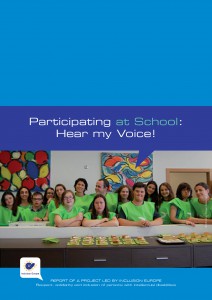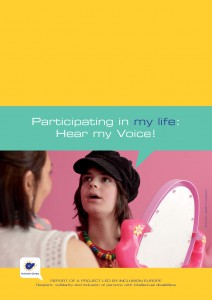A
The Hear our Voices project has proven to be extremely successful, with partners producing a wide range of publications, videos and training materials.
To inspire and motivate organisations working for and with children with disabilities, a good practice report on child participation was published, collecting interesting and thought-provoking projects in this field. The publication was meant to demonstrate that participation of ALL children in ALL environments is meaningful. Age-appropriate and accessible information should be available for children with disabilities and this may be achieved by using alternative communication methods, person-centred methods and direct consultation with children, their families and/or their close ones. You can read the report (only in English) here.
As a result of the training and teaching activities with children with intellectual disabilities, geared at helping the children to participate in various matters which affect them directly, tools for individual and collective participation have been developed to use at school, in small group homes and in large institutional settings.
The publication Participating in my life: Hear My Voice! describes participatory mechanisms in child care services, including in residential institutions. It also shows how to develop mechanisms to support the planning and monitoring of services, and ensure their quality.
The publication is available in English, French, German, Spanish as well as Bulgarian, Czech, Polish and Portuguese.
Cedar Foundation produced three videos about the young people and the work done with them on participation (with English subtitles):
QUIP also produced several inspiring videos:
- Matyáš – My communication video (with subtitles in English) about alternative communication.
- Hear Our Voices! Child participation in public decision-making (in Czech only)
- In the child best interest! (in Czech only)
The publication Participating at School: Hear My Voice! describes  participatory mechanisms at schools. It shows how schools can provide opportunities for children to be heard and to participate. It also demonstrates how children and their parents can be supported and trained to become advocates
participatory mechanisms at schools. It shows how schools can provide opportunities for children to be heard and to participate. It also demonstrates how children and their parents can be supported and trained to become advocates
The publication is available in English, French, German, Spanish as well as Bulgarian, Czech, Polish and Portuguese.
Five videos which illustrate how the different tools work in practice are available in Spanish.
- The assembly and my turn to speak
- My meeting
- Participation questionnaire
- Participation in the school board
- Satisfaction questionnaire
A video about the Step by Step programme is also available with English subtitles.
The Hear Our Voices Project also aimed to mainstream the idea of participation among children themselves in a fun but educative way. An animated movie will show practical ways of involving peers with intellectual disabilities designed by children themselves
The video is available in English, French, German, Spanish as well as Bulgarian, Czech, Polish and Portuguese. Don’t hesitate to circulate it on Social Media!
Finally, the Hear Our Voices Project also ensured the visibility of children with intellectual disabilities in child rights policies, legislation and practices at national, European and international levels. For this purpose, the project partners:
- developed a policy briefing on the EU strategy on children rights from a the perspective of the United Nations Convention on the Rights of Persons with Disabilities, with recommendations. You can read the paper here (only in English). The paper has been presented to European Commission representatives dealing with disability and child rights issues.
- organised a side-event meeting at the United Nations with members of both the Committee on the Rights of the Child and the Committee on the Rights of Persons with Disabilities on the 26th of October. The recommendations made at the side-event are available here.

